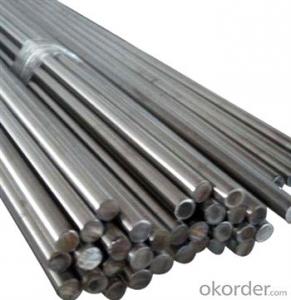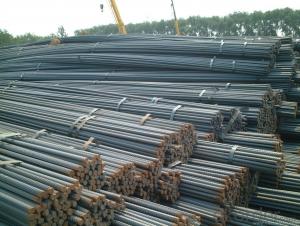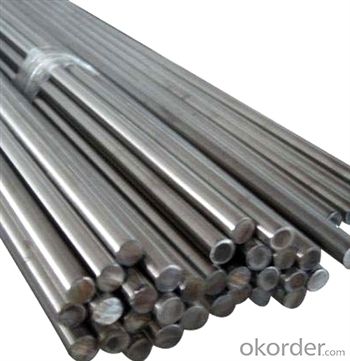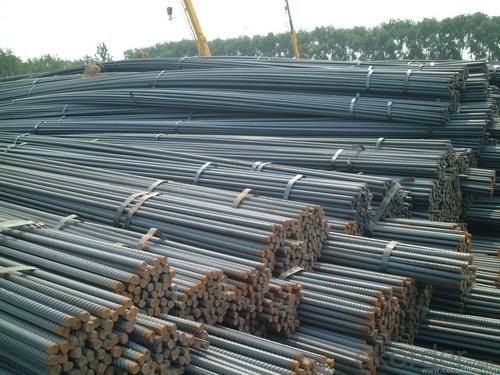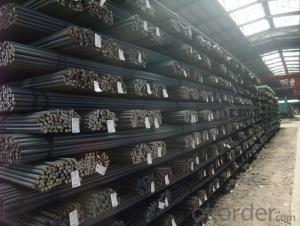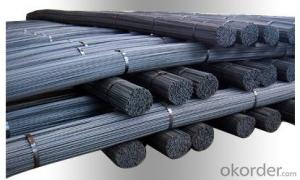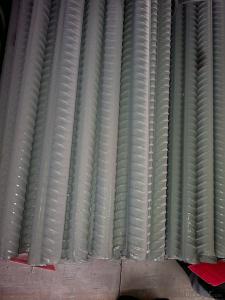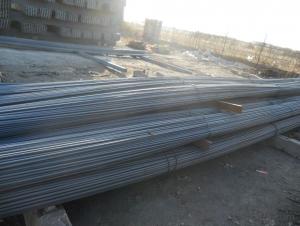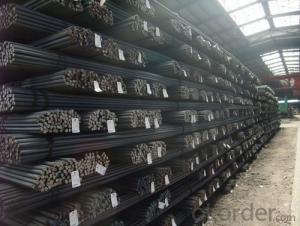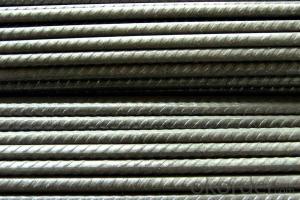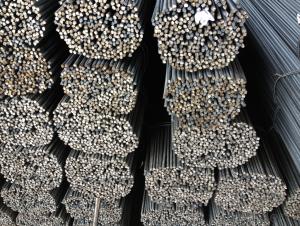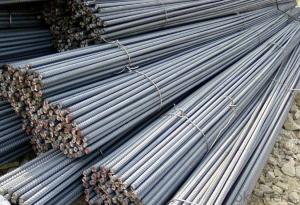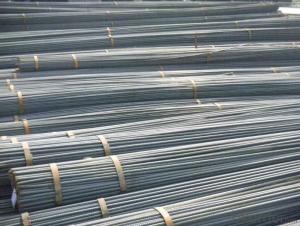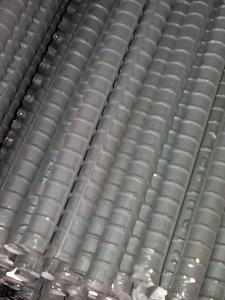Deformed Steel Bar / Hot Rolled Ribbed Bars
- Loading Port:
- Tianjin
- Payment Terms:
- TT or LC
- Min Order Qty:
- 500 m.t.
- Supply Capability:
- 5000 m.t./month
OKorder Service Pledge
OKorder Financial Service
You Might Also Like
Deformed Steel Bar / Hot Rolled Ribbed Bars
Description for Deformed Steel Bar
Type | Deformed Steel Bar/ Hot Rolled Ribbed Bar |
Standard grade | GB1499.2-2007, HRB335, HRB400, HRB500 and so on. BS4449/2005, B500A, B500B etc.. SD400, SD500, ASTM A615 Gr.40, Gr60 and so on.. |
Shape | Ribbed bars |
Quality | Prime quality |
Technique | Hot rolled |
Size of diameter | 12-32mm, as requested |
Length | 6~12m, as requested |
Delivery time | 10-30 days, according to the quantity |
Note | Customized service is available (for diameter, length and chemical components etc. |
Standard: AISI, ASTM, BS, DIN, GB, JIS, GB
Grade: HRB500
Diameter: 16mm-25mm
Model Number: DIA. 10-32mm
Application: Construction materials
Dimensions: 60*60mm-150*150mm
Technique: Hot Rolled
Chemical Composition: C, Si, Mn, P, S, (B)
Alloy Or Not: Is Alloy
Shape: Square
Secondary Or Not: Non-secondary
FAQ:
Why should you choose us:
1. More than 10 years experience in this industry
2. 100,000 tons exporting per month
3. Professional foreign trade tea
4. OEM&ODM capacity
5. High quality assured & competitive price
6. Try our best to meet your needs & save your budget
7. Very popular in Southeast Asia, Africa, Mid-East and South America etc.
8. VIP membership system, first time customers and long-term cooperation customers can get extra discount on some products.
Pictures:
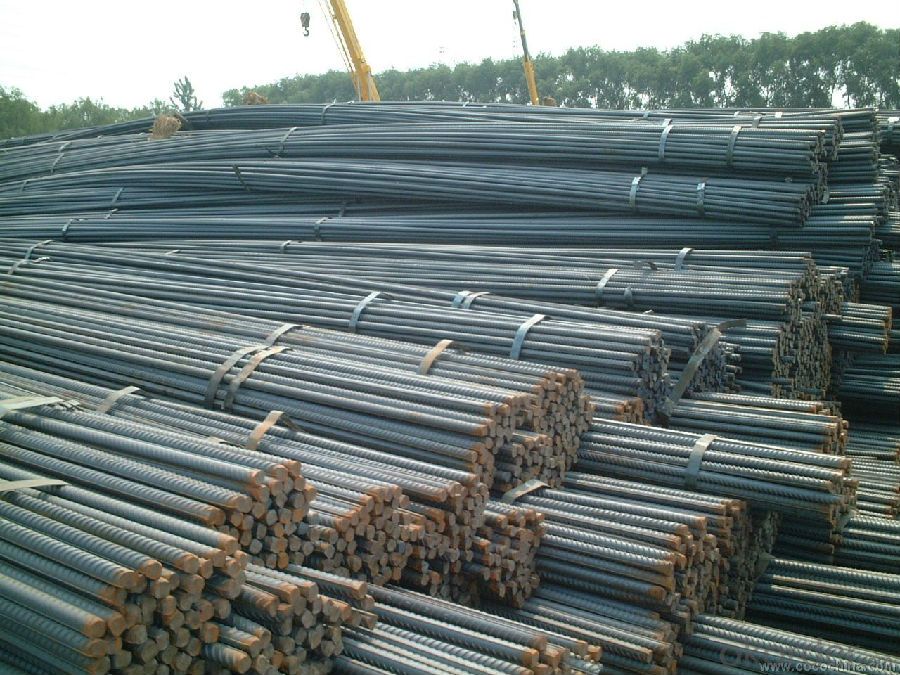
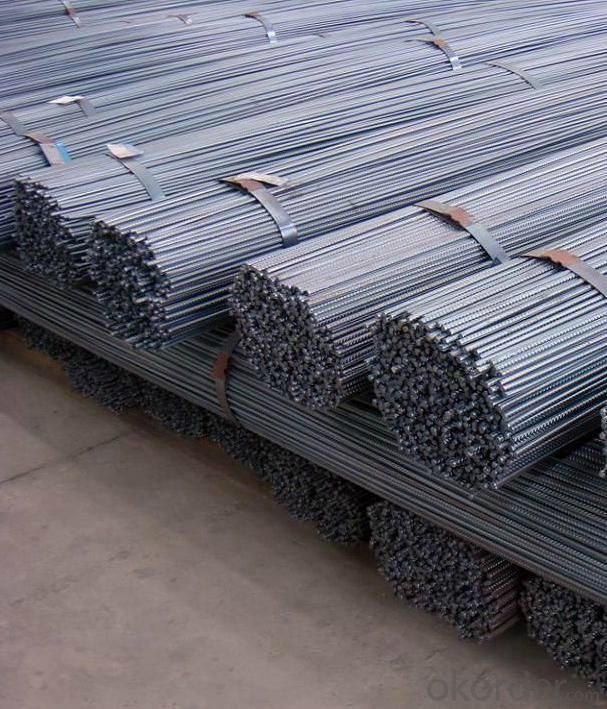
- Q: What is the process of reinforcing existing concrete structures with steel rebars?
- Enhancing the strength and durability of existing concrete structures with steel rebars involves a series of steps. To begin, a thorough assessment of the concrete structure is conducted to determine its condition and identify areas in need of reinforcement. This involves inspecting the concrete for cracks, signs of degradation, or any other structural issues. Once the areas requiring reinforcement are identified, the next step is surface preparation. This involves cleaning the concrete surface to remove any loose debris, dirt, or contaminants that could hinder the bonding of the rebars with the concrete. Various methods, such as pressure washing or sandblasting, can be used for this purpose. Following surface preparation, the rebars are strategically placed within the concrete structure. The positioning and spacing of the rebars are crucial to ensure optimal reinforcement and structural integrity. This is typically accomplished by drilling holes or creating channels in the concrete where the rebars will be placed. Afterward, the rebars are inserted into the holes or channels, ensuring proper alignment and securing. The rebars are typically cut to the required length and bent into the desired shape to meet the specific reinforcement needs of the structure. Once the rebars are in place, they are anchored or secured to the existing concrete by various means. This can be achieved through the use of epoxy adhesive, mechanical anchors, or embedding the rebars into fresh concrete poured around them. Finally, the concrete is restored to its original condition, covering the rebars and creating a smooth and even surface. This may involve patching up any holes or channels created during the reinforcement process and finishing the surface to match the surrounding concrete. In conclusion, the process of reinforcing existing concrete structures with steel rebars necessitates careful planning, proper surface preparation, precise placement of rebars, secure anchoring, and appropriate finishing to achieve a strengthened and long-lasting structure.
- Q: What are the different types of steel rebars used in high-rise buildings?
- There are several types of steel rebars that are commonly used in high-rise buildings due to their strength and durability. These include: 1. Mild Steel Rebars: Also known as black bars, these are the most commonly used type of rebars in construction. They have a low carbon content and are easily weldable, making them ideal for reinforcing concrete structures. 2. High Strength Deformed (HSD) Steel Rebars: These rebars have a higher tensile strength than mild steel rebars. They are made by cold twisting or stretching the mild steel bars, resulting in a deformed pattern on the surface that provides better bonding with concrete. 3. Corrosion-Resistant Steel Rebars: In high-rise buildings located in coastal areas or regions with high humidity, corrosion-resistant steel rebars are used to prevent rust and deterioration. These rebars are coated with epoxy or galvanized to protect them from moisture and corrosive elements. 4. Carbon Steel Rebars: These rebars are made of carbon steel and have a higher carbon content than mild steel rebars. They offer excellent tensile strength and are often used in high-rise buildings where additional reinforcement is required. 5. Stainless Steel Rebars: Stainless steel rebars are highly resistant to corrosion and can withstand extreme weather conditions. They are commonly used in high-rise buildings that require long-term durability and protection against rust. 6. TMT (Thermo-Mechanically Treated) Steel Rebars: TMT rebars are manufactured by subjecting mild steel bars to a combination of heat treatment and mechanical deformation. This process imparts superior strength and ductility to the rebars, making them suitable for high-rise buildings where seismic resistance is crucial. Each type of steel rebar has its own specific properties and advantages, allowing engineers and construction professionals to choose the most appropriate type based on the requirements and specifications of the high-rise building project.
- Q: What are the different types of steel rebars used in airport construction?
- There are generally two types of steel rebars commonly used in airport construction: epoxy-coated rebars and stainless steel rebars. Epoxy-coated rebars are corrosion-resistant and provide protection against chemicals often found in airports, such as de-icing agents. Stainless steel rebars, on the other hand, offer superior resistance to corrosion and are often used in areas with high humidity or exposure to saltwater. Both types of rebars are essential in ensuring the structural integrity and longevity of airport infrastructure.
- Q: How do steel rebars impact the overall construction timeline?
- The speed and efficiency of the construction process are greatly influenced by the presence of steel rebars. These rebars are essential for reinforcing concrete structures, providing them with strength, durability, and resistance. To begin with, the use of steel rebars contributes to faster construction by reducing the time required for concrete to cure. When embedded in concrete, rebars evenly distribute the load, resulting in a stronger structure and expedited construction. This is especially crucial for tall buildings or large-scale projects where time is of the essence. Furthermore, steel rebars enhance the structural integrity of the construction, ensuring its ability to withstand forces like earthquakes, wind, and heavy loads. By reinforcing the concrete, rebars prevent cracks and failures, thereby increasing the longevity and safety of the building. This eliminates the need for costly repairs or renovations in the future, ultimately saving time in the long run. In addition, the use of steel rebars allows for greater flexibility in design and construction. Architects and engineers can create intricate structures with curved or irregular shapes without compromising strength or stability thanks to the presence of rebars. This versatility reduces the time required for design modifications and construction alterations, ultimately expediting the overall timeline. Moreover, steel rebars are readily available in the market and conform to specific industry standards. This ensures a consistent supply of high-quality materials, minimizing delays caused by material shortages or issues with quality. Contractors can easily obtain rebars, facilitating a smooth workflow and timely completion of the construction project. In conclusion, steel rebars have a significant impact on the overall construction timeline. They expedite the construction process, enhance structural integrity, allow for design flexibility, and ensure a consistent supply of materials. By incorporating steel rebars into construction projects, contractors can save time, reduce potential setbacks, and deliver projects within the desired timeframe.
- Q: How are steel rebars stored and transported?
- Construction projects commonly use steel rebars, which are also known as reinforcing bars. The purpose of steel rebars in construction is to provide strength and stability to concrete structures. It is vital to properly store and transport steel rebars to maintain their quality and prevent any damage or accidents. Regarding storage, steel rebars are typically kept in a designated area known as a rebar yard or laydown yard. This area should be clean, well-drained, and free from debris or organic materials. To prevent corrosion or contamination, rebars are usually stacked in bundles or placed on elevated racks to avoid contact with the ground. To ensure safety and easy access, rebars should be organized and labeled based on their sizes and grades. This helps construction workers quickly identify and retrieve the required rebars without causing any disruption or delays in the project. When it comes to transportation, steel rebars are commonly loaded onto trucks or trailers for delivery to construction sites. It is crucial to secure the rebars adequately during transportation to avoid any shifting or movement that could damage the rebars or compromise the safety of the vehicle. Depending on their length and quantity, rebars can be transported in various ways. They can be bundled together using wires, straps, or steel bands to keep them in place. Additionally, wooden or metal supports can be used to prevent the rebars from bending or sagging during transit. During transportation, it is important to consider weight restrictions and road regulations to ensure compliance and safety. If rebars need to be transported over long distances, it is essential to coordinate with logistics companies that specialize in handling heavy and oversized cargo. In conclusion, steel rebars are stored in designated areas like rebar yards, where they are stacked, labeled, and protected from corrosion and contamination. During transportation, rebars are secured using wires, straps, or steel bands and loaded onto trucks or trailers. Proper handling and adherence to regulations are crucial to ensure the safety and integrity of the rebars during storage and transportation.
- Q: What is the effect of moisture on steel rebars?
- The effect of moisture on steel rebars can lead to corrosion, which weakens the rebars and reduces their structural integrity over time. Moisture can initiate the oxidation process, causing the rebars to rust and potentially compromise the stability of reinforced concrete structures. Regular inspection and maintenance are crucial to prevent and address any moisture-related damage to steel rebars.
- Q: How do steel rebars contribute to the overall occupant comfort of a building?
- Steel rebars play a crucial role in contributing to the overall occupant comfort of a building in several ways. First and foremost, steel rebars are used to reinforce concrete structures, such as walls, columns, and beams, which provide stability and strength to the building. This ensures that the structure can withstand external forces, such as wind, earthquakes, or heavy loads, without compromising the safety of the occupants. The reinforced concrete also helps to reduce vibrations, minimizing the discomfort caused by movement or shaking of the building. Additionally, steel rebars enhance the durability of the building, preventing cracks and deterioration over time. This is essential for maintaining a comfortable indoor environment as it helps to prevent water leaks, moisture penetration, and the growth of mold or mildew. By preventing these issues, steel rebars contribute to maintaining a healthy and comfortable living space for the occupants. Moreover, steel rebars are often used in the construction of high-rise buildings, which are prone to thermal expansion and contraction. By reinforcing the concrete structure, steel rebars help to minimize the effects of temperature changes, reducing the risk of structural damage and ensuring a consistent indoor temperature. This contributes to a comfortable environment for the occupants, as it helps to regulate the temperature and prevents drafts or heat loss. Furthermore, steel rebars also play a crucial role in fire resistance. Concrete structures reinforced with steel rebars have a higher fire resistance compared to other materials. This is because steel has a high melting point and does not burn, providing additional time for occupants to evacuate the building in the event of a fire. This increased fire resistance contributes to the overall occupant comfort by enhancing their safety and reducing the risk of injuries or fatalities. In conclusion, steel rebars contribute significantly to the overall occupant comfort of a building by providing stability, durability, thermal regulation, and fire resistance. Their role in reinforcing concrete structures ensures the safety, longevity, and functionality of the building, ultimately creating a comfortable and secure environment for the occupants.
- Q: What are the different types of steel rebars used in beam reinforcement?
- There are three main types of steel rebars commonly used in beam reinforcement: mild steel rebars, high-strength deformed steel rebars, and epoxy-coated rebars.
- Q: What does it mean to have 22 4GJ on the threaded steel?
- The letters on the reinforcement are registered plant names or trademarks. The top figures on the bar represent the grade of the reinforcement, such as 3 for grade 2 steel, 4 for grade 3 steel, and 5 for grade 4 steel. The numbers in the back represent the specifications of the bars, and the letters between grades and specifications represent the steel manufacturer.
- Q: What is the effect of steel rebars on the durability of concrete structures?
- The durability of concrete structures is greatly influenced by the presence of steel rebars. When used as reinforcement within the concrete, rebars bolster the strength and longevity of the structure. While concrete itself is strong when compressed, it lacks tensile strength. However, by incorporating steel rebars, which possess high tensile strength, into the concrete, the overall structural integrity is significantly improved. The inclusion of rebars in concrete serves to mitigate the potential for cracking and structural failure. When exposed to external forces or natural phenomena such as earthquakes or temperature fluctuations, the rebars distribute the load and aid in resisting bending, shearing, and tension forces. This effectively prevents the occurrence of cracks and ensures the concrete structure remains whole and stable. Furthermore, steel rebars also provide protection against corrosion for the concrete. Concrete is susceptible to moisture and chemicals that can penetrate its surface and lead to the corrosion of embedded reinforcement. However, rebars act as a barrier, safeguarding the concrete from moisture and harmful substances that could cause corrosion. This extends the lifespan of the structure and reduces the need for maintenance and repairs. In conclusion, the addition of steel rebars in concrete structures greatly enhances their durability. They offer increased strength, resistance to external forces, and protection against corrosion. When combined, concrete and steel rebars create a robust and long-lasting structure capable of withstanding various environmental and structural challenges.
Send your message to us
Deformed Steel Bar / Hot Rolled Ribbed Bars
- Loading Port:
- Tianjin
- Payment Terms:
- TT or LC
- Min Order Qty:
- 500 m.t.
- Supply Capability:
- 5000 m.t./month
OKorder Service Pledge
OKorder Financial Service
Similar products
Hot products
Hot Searches
Related keywords
